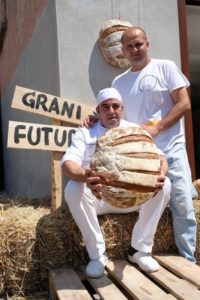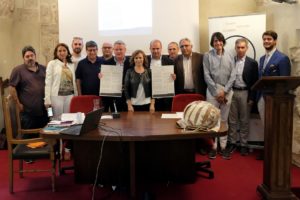 Unexpected numbers for the long weekend of ‘Grani Futuri’ (Future Grains, at its first edition), which gathered more than 15,000 people at San Marco in Lamis. In the convent of St. Matthew, the Futurist Manifesto of Bread was signed; it was designed by baker economist Antonio Cera and by Dr. Giampiero Di Tullio. Its main goal is to create a culture of bread in both taste and nutritional terms.
Unexpected numbers for the long weekend of ‘Grani Futuri’ (Future Grains, at its first edition), which gathered more than 15,000 people at San Marco in Lamis. In the convent of St. Matthew, the Futurist Manifesto of Bread was signed; it was designed by baker economist Antonio Cera and by Dr. Giampiero Di Tullio. Its main goal is to create a culture of bread in both taste and nutritional terms.
 Care, respect, and protection of the vital characteristics of agricultural land, where it is important to preserve and develop the different varieties, are the first indispensable foundation for ideal bread-making. The recommended cultivation techniques start from the minimum level corresponding to organic agriculture, to reach optimum with biodynamic agriculture and permaculture. For seeds and varieties, whose manifold diversity is the peculiar and valuable heritage of Italian territory, the use of autochthonous Italian grains, better if from old seeds and therefore characterised by lower gluten content, guarantees a less aggressive impact on consumer health, with particular reference to the increased immune tolerance to cereals and best digestive quality. The use of flours derived from these ‘future grains’ also ensures high value in terms of palatability, flavour, and nutritional profile. Finally, it favours the recovery of wise memories of working and cultural references of the land.
Care, respect, and protection of the vital characteristics of agricultural land, where it is important to preserve and develop the different varieties, are the first indispensable foundation for ideal bread-making. The recommended cultivation techniques start from the minimum level corresponding to organic agriculture, to reach optimum with biodynamic agriculture and permaculture. For seeds and varieties, whose manifold diversity is the peculiar and valuable heritage of Italian territory, the use of autochthonous Italian grains, better if from old seeds and therefore characterised by lower gluten content, guarantees a less aggressive impact on consumer health, with particular reference to the increased immune tolerance to cereals and best digestive quality. The use of flours derived from these ‘future grains’ also ensures high value in terms of palatability, flavour, and nutritional profile. Finally, it favours the recovery of wise memories of working and cultural references of the land.
It is essential to use flours with integral or semi-integral characteristics, which guarantee the maintenance of valid quantities of germ that can provide a high content of insoluble (cellulose, etc.) and soluble fibres, B and E group vitamins, trace elements and minerals, omega3 and omega6 polyunsaturated fatty acids, etc.
The operators who knead the dough cannot use any enhancer, and must choose flours that do not contain them. It is recommended to prepare dough with traditional ingredients: flour or semolina, water, yeast and salt, animal fat or exclusively extra virgin olive oil. No use of products that allow working the dough more readily, or giving bread durability and digestibility. These features can be obtained naturally, without additions, simply with proper baking.
It is strongly recommended to use fresh yeast base to partially reduce the gluten content and give greater digestibility to the bread. Either manual processing of the dough or use of mechanical means that minimise the transfer of heat to the dough are recommended. It is important to bake with plate oven, that is with heated base, which can be fired with wood, gas, or electricity.
For conservation, it is recommended to use natural fabrics in raw cloth or canvas.
